
Esta á a melhor época da horta, com todos os vegetais a crescerem de dia para dia. Vamos dar uma olhadela ao que cresce cá na horta. Começamos com as alfaces (cerca de 10 variedades).
The best time of year is starting in the veg garden. Vegetables are growing like mad. Lets have a look at what is growing , shall we?. Lettuce to start with (10 different varieties. Can you tell I like lettuce?)
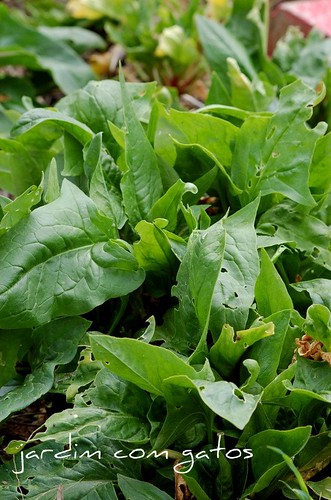
Espinafres. Estes foram semeados no inicio do ano, mas só agora é que estão realmente a crescer. Tenho comido espinafres quase todos os dias.
Spinach. These were sowed early this year, but it only really started to grow a few weeks ago. I'm eating spinach almost every day now.
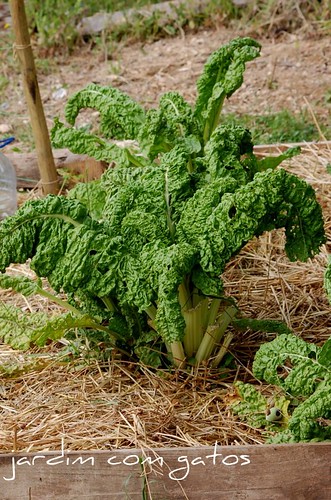
Acelgas. Estas foram uma surpresa agradável. Nunca tinha comido antes de as semear na horta. Semeei-as o ano passado mas só este ano começaram a crescer como deve ser.
Swiss chard. I had never tried these before growing them (you wont find them for sale around here) and they were a very pleasant surprise. They were sowed last year but they hardly grew during Summer. With the cooler temperatures they are growing very well. And they are delicious.
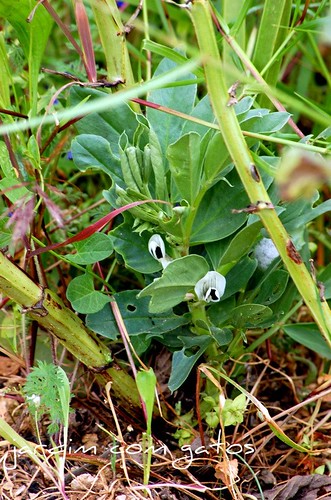
As favas voltaram a rebentar e a dar flores. Parece que vamos ter mais favas.
Broad beans are growing and blooming again. Looks like we will have more broad beans.

Ervilhas. Apenas 4 sementes germinaram, pelo que este ano ainda não as vou poder provar. No entanto parece que vou ter bastantes sementes para o ano.
Purple podded peas. I'm not eating these this year. Since I had only 4 seeds sprouting I have to save all the seeds for next year. Looks like I will have enough.
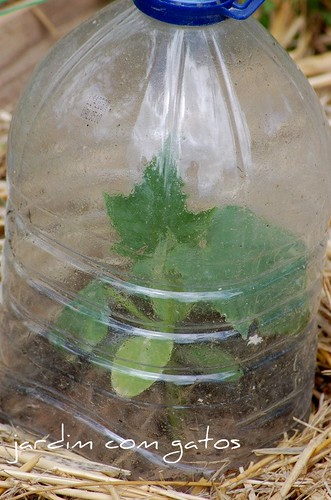
Pepinos. Ainda dentro dos garrafões mais por causa do frio que dos caracóis. Quando o tempo voltar a aquecer logo os destapo.
Cucumbers. They are still under the plastic bottles because its still a bit cold. They will be uncovered once the weather warms up.

As batatas estão a crescer bem.
Potatoes are growing nicely.

Algumas couves tronchudas que ainda ficaram do Inverno.
A few cabbages left from winter planting.
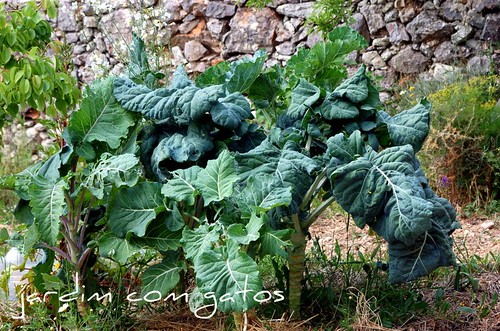
Couve galega. Debaixo da qual o Pascoal passa os dias a vigiar a horta.
Kale (I believe its called walking stick kale).
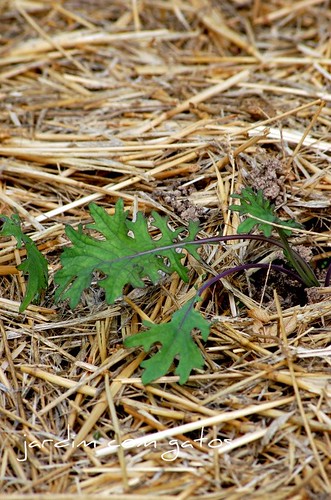
Este é um outro tipo de couve que semeei este ano. Red russian kale (não faço ideia que nome terá em português)
Red russian kale. Its also a novelty to me. We will see how it grows (and how it tastes)

Nabos.
Turnips

Tomates. Ainda está um bocadinho frio, mas eles parecem estar a aguentar-se bem.
Tomatoes. Its still a bit cold but they seem to be doing just fine.
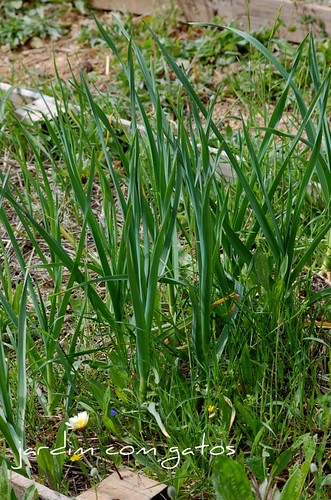
Alhos
Garlic
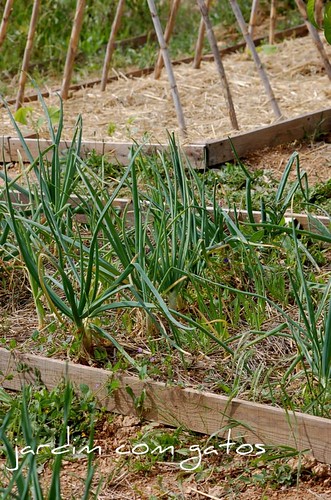
Cebolas
Onions
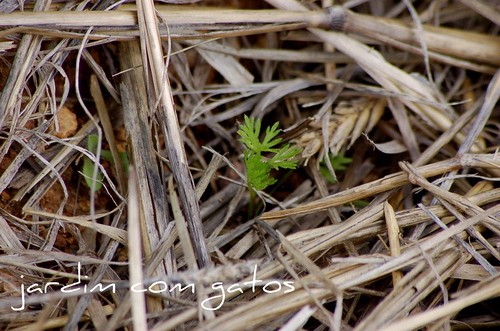
Lembram-se das cenouras que ia transplantar? Estão a crescer bem no meio das cebolas.
And the baby carrots I transplanted are growing just fine amongst the onions.
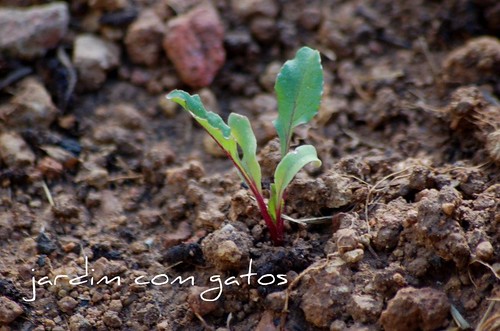
Beterrabas, recentemente transplantadas. Já não passo sem beterrabas (há um ano atrás detestava)
Recently transplanted beets. I can't be without them (funny to think I used to hate them before growing them in my garden)

E para finalizar, outra coisa completamente nova. Oca.
Oca. this is another new crop to me. I have no idea what the tubercles will taste like.
12 comentários:
Oca é uma espécie de quê? :)
Sabes que tenho inveja desse teu quintal, né? Nem digo mais nada!
e eu! Gostava de ter um espaço assim. Bem tenho um pequeno espaço que são dos meus avôs mas nao fica perto da area de residencia :S
Your veggies look delicious. I love kale. I haven't had the "walking stick" kind. I bet they are all good.
It all looks wonderful, especially the purple podded peas. Did you know that if you pull the chard leaves away from the plant, rather than cut them, you get the stem too which you can cook separately. We eat the stems on their own with a little olive oil and parmesan cheese, then have the leaves as a vegetable like spinach.
Magiv on the veg - where in Portugal are you? Stu x
as fotos de alhos e cebolas não estaram trocadas? a foto das cebolas parecem alhos e os alhos parecem cebolas. como se chamam essas ervilhas com essa cor estranha? e essas couves russas são esquesitas. este ano vou pela primeira vez cultivar as beterrabas. aceito é sugestões de receitas.
ameixa, oca é da familia das Oxalis.O q se come é a raiz. Aqui podes ver uma foto dos tuberculos (http://jardimcomgatos.blogspot.com/2009/03/novas-culturas-new-crops.html)
Mar.garida, mesmo num apartamento podes sempre cultivar algumas coisas em vasos.
Lisa, the "walking stick" kale is very common around here. Almost every one grows it. Its very tasty.
chaiselongue, I will have to try, I usually trow the stems to the compost bin.
stuart, in the Algarve, Loulé.
manuel, não, é mesmo assim, as fotos estão correctas.As ervilhas são Capucijners, uma variedade holandesa. Não vejo nada de esquisito nas couves. Qto às beterrabas, a melhor maneira de as comer, na miha opinião, é assadas no forno com azeite e alho.
Estas fotos até abrem o apetite...
Realmente a oca não conhecia...
Rico jardim o teu...
Jokas
Sandra C.
Olá gintoino! Desde já parabéns pela horta que tanto "invejo". Tenho uma dúvida em que acho que me podes ajudar...Tenho umas sementes de aneto e manjericão para semear. Achei que a técnica dos garrafões seria boa porque no fundo ajuda as sementes a crescerem mais rápido uma vez que estão mais protegidas e a uma temperatura de "estufa". No entanto, não percebo bem como se faz a coisa com os garrafões...Podes explicar-me assim tim-tim por tim-tim ?
Sooo glad to hear the walking stick kale is tasty! I bought seeds (and they've come up already) thinking it would be interesting ornamentally at least, but wasn't sure about the taste. So I'm very excited to hear it's tasty.
Do you think it needs a hot summer to grow tall?
I'm worried that in San Francisco, where normal kale grows fine during our cool summers, it might not be hot enough to grow tall.
Do people really use the "stick" for anything? I read that it's stronger than bamboo.
Miguel, vê aqui http://jardimcomgatos.blogspot.
com/2008/01/semear-e-reciclar-sowing-and-recycling.html. Está tudo esplicadinho "tim-tim por tim-tim" ;-)
chuck, mine was sowed last autumn and it grew fine during winter time. In fact I think it might prefer cooler weather. We use it mainly for soups, but I also like it stir fried. I never eared about using the "stick" for anything...
Here's an article about harvesting the stick, fyi:
http://tomclothier.hort.net/page32.html
Enviar um comentário